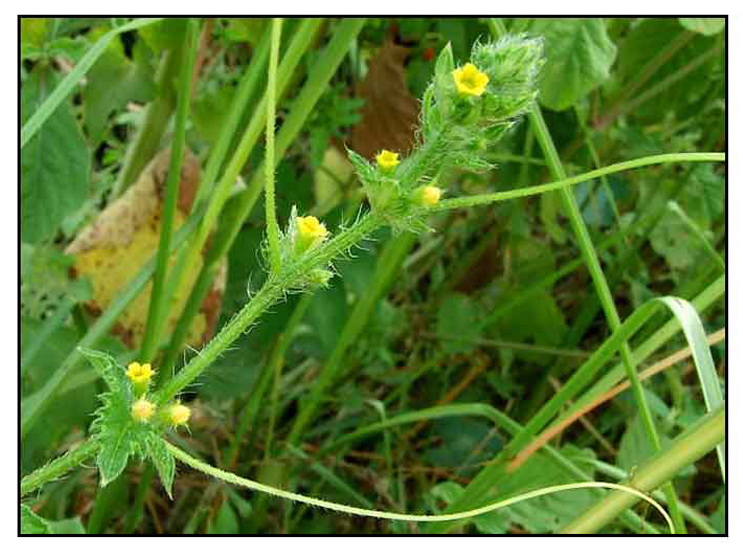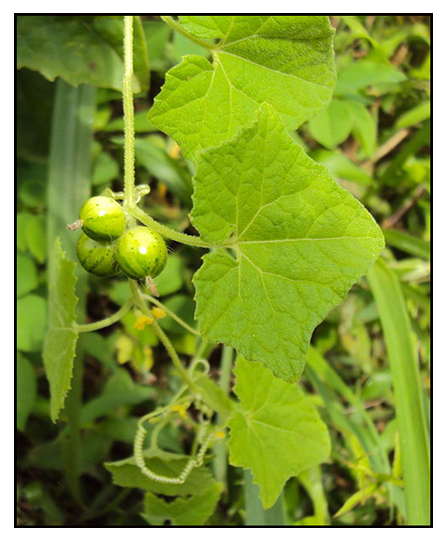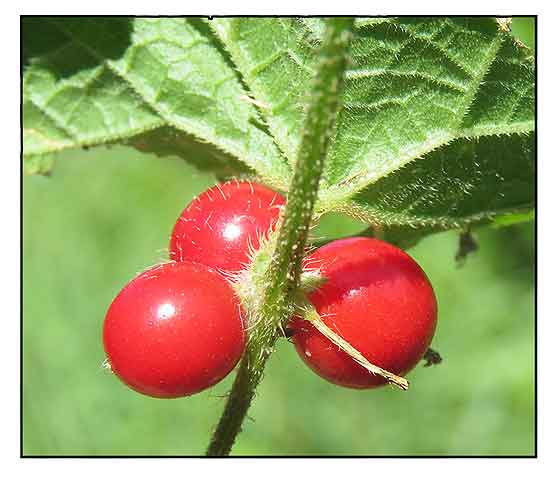
Gen info
- Cucumis is a genus of twining, tendril-bearing plants in the family Cucurbitaceae, which includes the cucumber (Cucumis sativus), muskmelons (C. melo), the horned melon (C. metuliferus), and the West Indian gherkin (C. anguria).
 Botany Botany
Melon-gubat is a perennial herb with simple tendrils. Stems are climbing, long, slender, much-branched, angular, and covered with spreading, bristly hairs, with the young parts densely covered with white hairs. Leaves are ovate or triangular-ovate, variable in size, usually 5 to 9 centimeters long (but often only 2.5 to 4 centimeters) and 2 to 8 centimeters wide, very deeply heart-shaped at the base, pointed or obtuse at the apex, rather shallowly 5-lobed, coarsely toothed at the margins, and usually rough. Petioles are fully half as long as the leaves. Flowers are yellow and very small, the males occurring in fascicles and the females, singly. Calyx is hairy, with linear segments. Petals are ovate, and only about 2 millimeters long. Fruit is a berry, scarlet when ripe, rounded, 10 to 12 millimeters in diameter, and furnished with a few scattered hairs. Seeds are closely packed, ovoid, oblong, about 4 millimeters long, and compressed in the pulp.
Distribution
- Native to the Philippines.
-
In open grasslands, old clearings, etc., at low and medium altitudes in Batan Island; Lepanto and Bontoc Subprovinces; Cavite and Laguna Provinces in Luzon; in Masbate; in Palawan and Mindanao.
- Also native to Andaman Is., Angola, Assam, Australia, Bangladesh, Benin, Borneo, Burkina, Burundi, Cambodia, Central African Repu, Chad, Congo, East Himalaya, Eritrea, Ethiopia, Gambia, Guinea, Guinea-Bissau, India, Ivory Coast, Jawa, Kenya, KwaZulu-Natal, Lesser Sunda Is., Madagascar, Malawi, Malaya, Mali, Mauritania, Mozambique, Myanmar, Nansei-shoto, Nepal, New Guinea, Nicobar Is., Niger, Nigeria, Northern Provinces, Northern Territory, Oman, Pakistan, Queensland, Rwanda, Senegal, Sierra Leone, South Australia, Sri Lanka, Sudan, Sulawesi, Sumatera, Swaziland, Tanzania, Thailand, Togo, Uganda, Vietnam, Zambia, Zaïre, Zimbabwe. (22)
 Constituents Constituents
- Studies have yielded sugar, coumarins, amino acids, flavonoids.
- Phytochemical screening yielded flavonoids, saponins, and tannins.
- Screening of aerial parts yielded alkaloids, flavonoids, triterpenes and glycosides.
- Phytochemical studies of leaves have yielded spinasterol, 22,23-dihydrospinasterol, ß-sitosterol, decosaenoic acid, triterpenes, phenolic compounds, and glycosides.
- Roots have yielded columbin.
-
Seeds have yielded linolenic, lenoleic and arachidic acids.
- Extracts of ether, chloroform and ethyl acetate extracts of Melothria maderaspatana aerial parts yielded
steroids, triterpenes, and phenolic compounds. Studies have reported docosanoic acid, β- sitosterol and a pentaalochol. (13)
- Phytochemical screening of leaves yielded mainly dichloroacetic acid, 4-methylpentyl ester, 2-Butyn-1-ol, 4-methoxy, along with other constituents like flavonoids, saponins, carbohydrates, steroids, tannins. (29)
- Various leaf extracts yielded
alkaloids, saponins, glycosides, carbohydrates, phenols/tannins, flavonoids, and steroid/terpenoids. Various stem extracts yielded alkaloids, saponins, glycosides, carbohydrates, flavonoids, and steroid/terpenoids. (36)
Properties
- Sudorific, anti-flatulence, laxative.
- Studies suggest anxiolytic, anti-hypertensive, anitmicrobial, anti-hyperglycemic, anti-inflammatory, antiarthritic, anti-platelet, antioxidant, diuretic, gastroprotective, hypolipidemic, hepatoprotective, immunomodulatory properties.
Parts used
Seeds, roots, leaves.
 Uses Uses
Edibility
- Fruits reportedly edible.
Folkloric
- Seeds in decoction are sudorific; used for flatulence.
- Powdered leaves dusted over scabies.
- Crushed seeds used for aching bodies, especially with sprained backs.
- Seeds masticated to relieve toothache.
- Decoction of roots used for flatulence; when masticated, relieves toothaches.
- Tender shoots and bitter leaves are used as gentle aperient; also, for vertigo and biliousness.
- Roots used as diuretic and as laxative in constipation.
- Leaf sap given to children for treatment of amoebiasis. Leaf-sap used in wound dressings. Plant ash mixed with castor oil and rubbed over temples for relief of headache.
Fruit used as vermifuge. Roots chewed for relief of facial neuralgia and toothache; root decoction used for flatulence. (41)
- In India, some tribes used the plant for diabetes.
Also used for fever, anxiety, and to improve appetite.
- In West Bengal, India, leaves, roots, and seeds used for anorexia, arthritis, and acid reflux and as anti-inflammatory. (40)
Studies
• Antihyperlipidemic / Cardio-hepato-renal Protective: Study of crude ethanolic extract of leaf on deoxycorticosterone acetate (DOCA)-salt hypertensive rats showed protective effects on the liver, kidney, and heart. Histopathology on the organs showed reduced damages towards normal histology. The protective effect was attributed to its antihyperlipidemic activity. (2)
• Antihyperglycemic / Free Radical Scavenging: An aqueous extract of Mm showed significant antihyperglycemic, hypocholesterolemic, and free radical scavenging activities in STZ-induced diabetic rats. (3)
• Antioxidative Constitution of Leaves / Radical Scavenging and Metal Chelating Activities: Study isolated saponarin, a major phenolic antioxidant, together with phenolics, flavonoid, carotenoids, vitamins C and E. The leaf extract showed potent in vitro antioxidant/radical scavenging and metal chelating activities. (4) Study evaluated various concentrations of aqueous extract of leaves for invitro antioxidant activity using various free radical scavenging assays such as DPPH, superoxide anion radical, ABTS, hydroxyl radical, H2O2, and reducing power assay. All concentrations of the leaf extract exhibited free radical scavenging and antioxidant power and preventive effects in a dose dependent manner. Antioxidant effect was compared to standards such as BHT, ascorbic acid, and α-tocopherol. (38)
• Postprandial Glucose-Lowering Activity: Study of extract of leaves in mice showed glucose-lowering activity within an hour of glucose load, probably partially through inhibition of sugar absorption in the small intestine. The effect was not as persistent as standard drug metformin. (5)
• Anxiolytic / Leaves: Study evaluated the anxiolytic activity of a hydro-alcoholic extract of leaves in Wistar albino rats through the elevated plus maze test in rats and socio-behavioral deficit test in mice. Results showed anxiolytic activity as shown by significant (p<0.05) increase in entry as well as time spent on open arm in maze test and reduced attempts at escape in the deficit test. (6)
• Antihypertensive / Leaf-Tea: Study results showed M. madaraspatana leaf-tea consumption gradually decreased BP and showed beneficial effects of lipid profile, fibrinogen, bilirubin and body mass index. (7)
• Comparative Antimicrobial Activity: In antimicrobial testing, the methanolic extract of the Sri Lankan variety of M. maderatapana showed pronounced activity against E. coli. A hexane extract of the Indian variety showed moderate antibacterial activity. Antifungal activity was negligible for both varieties. (8)
• Hypolipidemic: Study of hypolipidemic effect of aqueous extract of whole plant in high fat diet fed rats showed significant reduction in the lipid level comparable with the Navaka guggulu.
• Blood Pressure Control / Electrolyte and Catecholamine Effect: Study evaluated the protective effect of ethyl acetate fraction of Mm leaf. Results showed good blood pressure control by enhancement of potassium and decrease of sodium levels, decrease epinephrine and catecholamines, prevention of eNOS down-regulation, and significantly down-regulating ET-1 protein expression. (9)
• Antioxidant: Study of aqueous extract of leaves for in vitro antioxidant activity showed effective scavenging of hydroxyl radical, hydrogen peroxide and superoxide anion radicals. It also scavenged DPPH and ABTS radicals, and was also found to have reducing power. All leaf extract concentration showed dose-dependent preventive effects. (10)
• Anti-Diabetic / Phloroglucinol and Mukia: Study evaluated Mukia extract and phenolics (quercetin and phloroglucinol) for in vitro antidiabetic activity. Phloroglucinol inhibited 100% of glucose production with or without insulin. Mukia inhibited gluconeogenesis by 45%. Mukia had no effect on glucose uptake, but potentiated the action of insulin-mediated glucose uptake. Results support the use of Mukia in folk medicine as antidiabetic nutraceutical. (12)
• Antiplatelet Activity / Aerial Parts: Study evaluated the effect of M. maderaspatana in platelet aggregation. An ethyl acetate extract showed dose-dependent antiplatelet activity. The degree of platelet aggregation was 50% when compared to standard Aspirin. (14)
• Anthelmintic: Study evaluated aqueous and ethanolic extracts of Mukia maderaspatana and Sida cordata for anthelmintic activity against common Indian earthworm, Pheretima posthuma, using Albendazole as standard. Aqueous extracts showed good activity compared to the ethanolic extracts. (15)
• Anti-Diabetic / α-Glucosidase and α-amylase inhibitory activities: Study evaluated the invitro antidiabetic activity of an ethanolic extract of Mukia maderaspatana. Results showed dose dependent inhibition of α-glucosidase and α-amylase enzyme, with lower inhibitory activity than acarbose. (16)
• Antioxidant Properties from Different Parts: Study showed leaves of M. maderaspatana is rich in ascorbic acid, higher than in fruits. The leaves also contain adequate amounts of phenolics and flavonoid contents higher than fruits. (17)
• Antihyperglycemic / Hypolipidemic Effects: Ethanol extracts of aerial parts were evaluated in STZ induced diabetes in Sprague-Dawley rats. Results showed significant antihyperglycemic and hypolipidemic effects, with glibenclamide as standard. (18)
• Diuretic: A hydroalcoholic extract of a powdered form of the plant showed significant diuretic activity when compared with standard drug azetazolamide. (19)
• Anti-Ulcer / Leaves: Study evaluated the anti-ulcer activity of crude aqueous extract of dried powdered leaves against stress induced ulcer models. Treatment with M. maderaspatana significantly restored the biochemical stress markers (MDA, GSH, gastric juice, volume and pH) to normal levels. (20)
• Antihypertensive / Leaves: Study evaluated the antihypertensive effect of ethanolic extract of MME leaves on sham-operated and uninephrectomized DOCA-salt induced hypertensive male albino Wistar rats. Results showed significant reduction of blood pressure. (24)
• Nanoparticles / Antibacterial / Leaves: Study reports on the synthesis of chromium oxide nanoparticles with Mukia maderaspatana plant extract. The antibacterial effect of Cr2O3 nanoparticles against E. coli was investigated. The particles showed to be an effective bactericide. (23)
• Effects of Leaf Tea Consumption: Study on the effects of leaf-tea consumption on hypertensive volunteers showed gradual reduction of blood pressure and beneficial effects on blood lipid profile, fibrinogen and body mass index in patients with hypertension. (25)
• Larvicidal Against Dengue Mosquito Vector Aedes aegypti: Study evaluated the effect of plant extracts of H. indicum and M. maderaspatana on different larval instars and pupae of A. aegypti. Essential compounds were used for control of larvae while extract was used for control of mosquitoes. Results showed a potential for utilization of the two plant species for control of Aedes aegypti. (26)
• Anti-Inflammatory: Study evaluated the in vitro and in vivo anti-inflammatory activities of whole plant methanolic extract of M. maderaspatana. The extract showed significant activity against protein denaturation and proteinase inhibition. It also showed reduction of paw edema in carrageenan induced rat. There was also significant inhibition of enzymatic antioxidant viz. SOD, CAT, GPx, and GST. (27)
• Antiulcer / Gastroprotective: Study investigated the gastroprotective effects of ethanolic extract of MM against indomethacin-induced gastric ulcer in rats. MM produced significant reduction in gastric mucosal lesions, malondialdehyde and serum tumor necrosis factor-α, with a significant increase in gastric juice mucin content and gastric mucosal catalase. NO, and prostaglandin E2 levels. The anti-ulcer effect was confirmed histologically. (28)
• Antidiabetic / Hypolipidemic: Study investigated the anti-diabetic effects of M. madaraspatana and its possible mechanism of action in STZ-induced diabetic rats. Results showed antidiabetic activity as evidenced by decreased serum FBG, with decreased TC, triglycerides, LDL-C, and VLDL-C, as well as increased levels of HDL-C. The benefits were attributed to a strong antioxidant activity as evidenced by increased CAT, SOD, and decreased MDA. (30)
• Anticancer / Leaves: Study investigated the anticancer potential of M. maderaspatana leaf extracts against human colon cancer cell lines (Colo320). Results showed significant cytotoxicity with induction of apoptosis and upregulation of enzymes vital to apoptosis. (31)
• Immunomodulatory / Human Complement System: Study evaluated the effects of aqueous extracts of Melothria maderaspatana whole plant, O. octandra whole plant, and P. debelis leaves on human immune system. The extracts showed strong in vitro anticomplement effects on both classical and alternate pathways of the human complement system. Effects were dose dependent and more pronounced in the classical complement pathway. (32)
• Renal Protective
/ Uninephrectomized DOCA-Salt Hypertensive Rats / Leaves:Study evaluated the renal protective effect of ethyl acetate fraction of MM leaf extract on uninephrectomized deoxycortisone acetate (DOCA)-salt hypertensive rats. Results showed EAFM provided good blood pressure control and renal protective effects as evidenced by significantly lowered blood pressure and improved renal function markers of urea, uric acid, and creatinine, along with a significant decrease in levels of renin, angiotensin II and aldosterone. (33)
• Antidiabetic / Roots: Study evaluated the antidiabetic activity of methanolic root extract of Mukia maderaspatana in alloxan induced diabetic rats. The extract showed significant (p<0.01) reduction of blood glucose,, lipid profile (except HDL), and serum enzymes, along with significantly increased (p<0.01) increase in total protein. (34)
• Protection Against D-Galactosame
and TBH Induced Hepatocyte Damage:Study evaluated the effect of M. mederaspatana extract on damage induced in freshly isolated rat hepatocytes by D-galactosamine and tert-butyl hydroperoxide (TBH). Results showed reduction in TBH-induced lipid peroxidation. Post-treatment, the extract protective activity was found to decrease with increase in time of exposure of cells to either of the toxins. (35)
• Amelioration of STZ-Induced Diabetes Mellitus and Lipid Profile: Study evaluated the antidiabetic and antioxidant effects of extracts and fractions of M. maderaspatana in STZ-induced diabetic rats. Results showed potent antidiabetic activity along with improvement of lipid and lipoprotein levels. (37)
• Gold and Silver Nanoparticles / Anticancer: / MCF-7 Breast Cancer Cell Line Study investigated the invitro cytotoxic effect of biosynthesized metal nanoparticles on MCF-7 breast cancer cell lines. Gold and silver nanoparticles were synthesized using M. maderastapanaa plant extract. The NPs showed significant cytotoxic effects with IC50 of 44.8 µg/g for gold NPs and 51.3 µg/g for silver NPs. (39)
Availability
Wild-crafted. |

![]()







